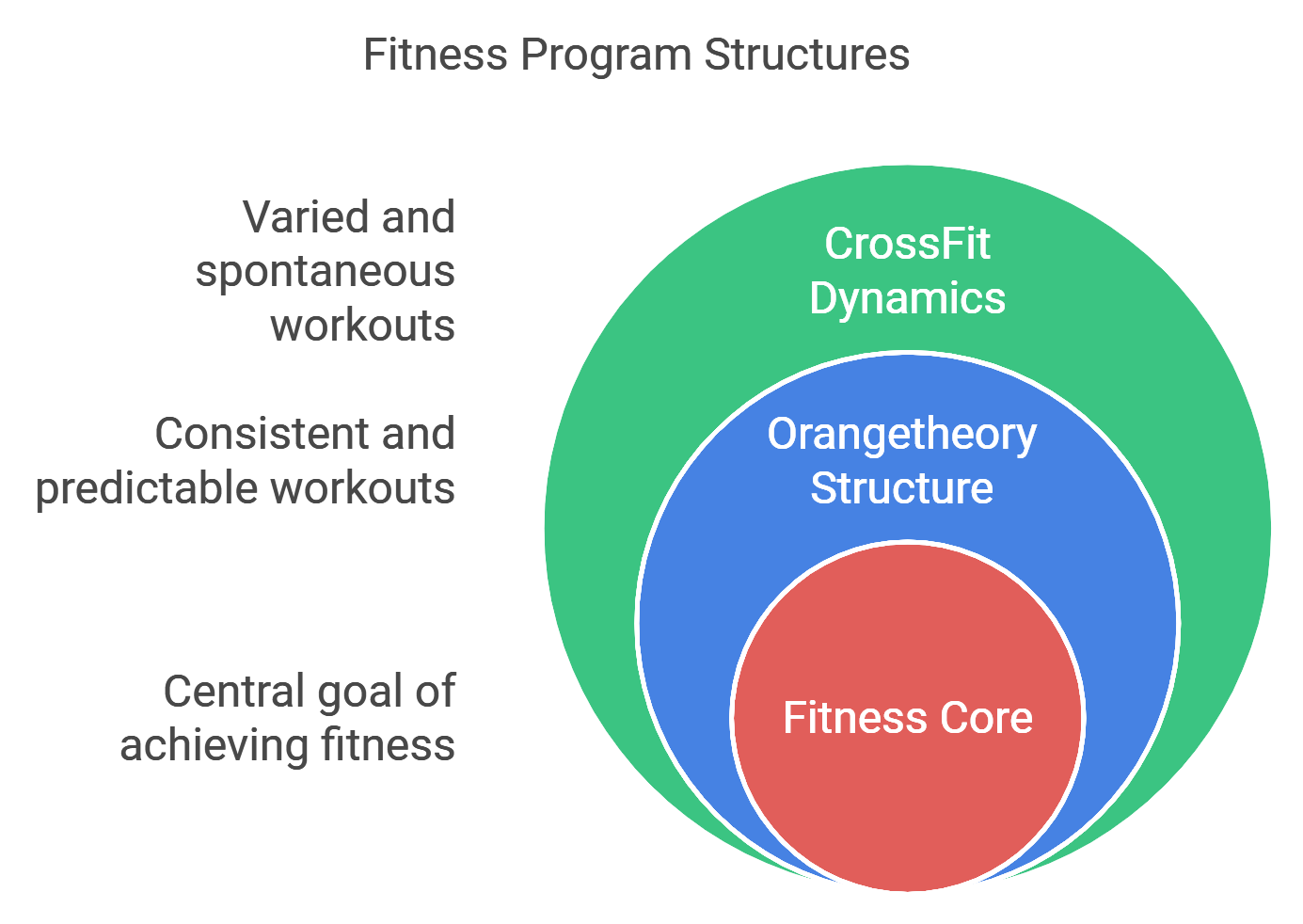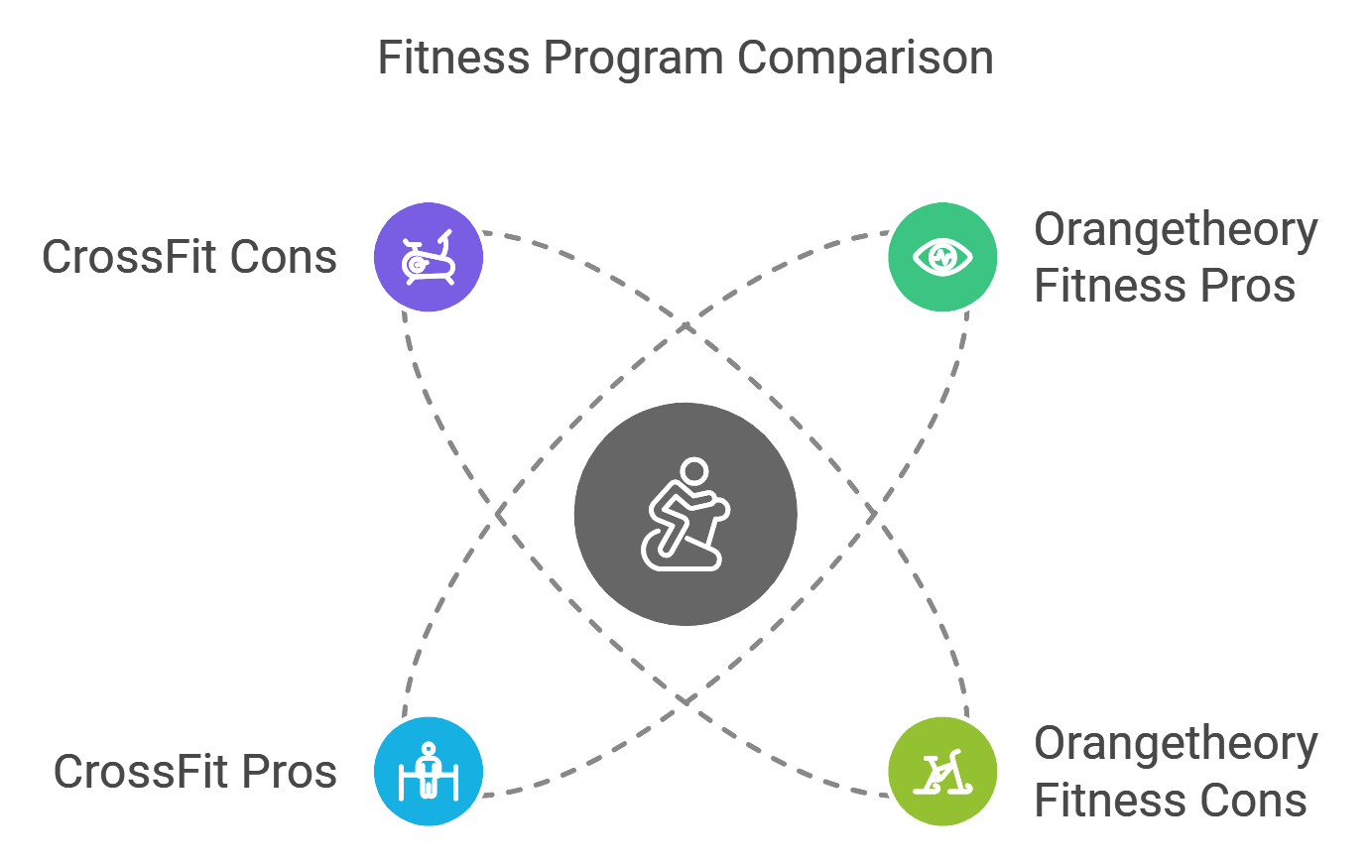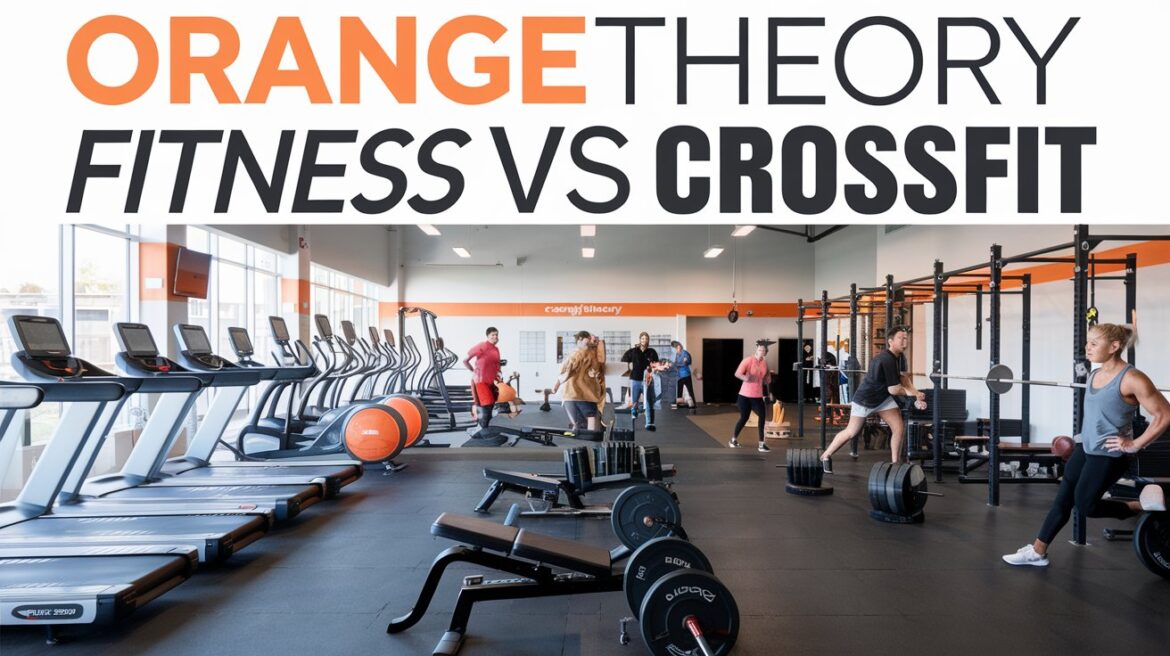Choosing the right workout program can be a daunting task. With so many options available, it’s essential to find one that aligns with your fitness goals and lifestyle.
Two popular choices are Orangetheory Fitness and CrossFit. Both are high-intensity fitness programs, but they differ in their approach and methodology.
Orangetheory Fitness, founded by Ellen Latham, is known for its heart rate-based cardio training. It uses a patented workout formula designed to maximize calorie burn and increase endurance.
On the other hand, CrossFit, created by Greg Glassman, emphasizes functional movements and strength training. It’s a program that prepares individuals for any physical contingency, with workouts varying in length and intensity.
In this article, we’ll delve into the key differences and similarities between these two fitness programs. Whether you’re a fitness enthusiast or a beginner looking for a new workout routine, this comparison will help you make an informed decision.
So, let’s dive in and start comparing Orangetheory Fitness and CrossFit workouts.
Understanding Orangetheory Fitness and CrossFit
Orangetheory Fitness was established by Ellen Latham, a skilled physiologist, in 2010. Her goal was to create a fitness program that combines science with exercise, resulting in a heart rate-based cardio workout. Today, Orangetheory is well-known for its high-intensity interval training (HIIT), making it a popular choice for those seeking structured cardio workouts.
CrossFit has its roots in Greg Glassman’s vision, which began taking shape in the early 2000s. Glassman introduced CrossFit as a workout program aimed at improving all areas of fitness, from strength to endurance. His idea was to create a regimen that uses functional movements performed at high intensity.
Here’s a quick look at the key principles of each program:
- Orangetheory Fitness: Focuses on maintaining heart rates in specific zones for optimal calorie burn, emphasizes cardio training.
- CrossFit: Prioritizes varied workouts designed to increase functional fitness, integrates strength training.
The essence of Orangetheory lies in its commitment to cardio improvement through dynamic workouts. Participants follow a standardized routine using heart rate monitors to track progress.
CrossFit, however, is about embracing diversity in workouts. It involves a mix of bodyweight movements, Olympic lifting, and high-intensity challenges, tailored to enhance physical capabilities for everyday life situations.
Workout Structure and Class Format
A typical Orangetheory class is a well-orchestrated session lasting 60 minutes. It begins with a brief warm-up, followed by alternating intervals of running, rowing, and strength exercises. This structured routine aims to keep participants in the “Orange Zone,” the optimal heart rate range for calorie burn.
The class involves the use of specialized equipment, including treadmills, rowing machines, and free weights. Coaches guide participants through the workout, ensuring that everyone follows the set pace and intensity levels.
CrossFit classes differ significantly in their approach. Known as “boxes,” CrossFit gyms conduct sessions led by coaches that vary daily. These workouts, famously called “Workouts of the Day” (WODs), combine elements like weightlifting, gymnastics, and endurance exercises.
The focus is on functional movements such as squats, lifts, and jumps. Each WOD is unique, designed to challenge various fitness aspects, offering scalability for different abilities.
Let’s compare the two workout formats:
- Orangetheory Fitness:
- Consistent 60-minute classes.
- Heart rate monitored to maintain specific intensity zones.
- Structured for uniformity across all studios.
- CrossFit:
- WODs vary daily in length and style.
- Emphasis on completing tasks in optimal time.
- Encourages personalized pacing and scaling.
Orangetheory offers predictability and rhythm, which is appealing for many seeking routine. In contrast, CrossFit thrives on the excitement of surprise and evolving challenges. Its dynamic format attracts those looking for diversity in their workouts, catering to personal growth and spontaneity.

Training Focus and Methodologies
Orangetheory Fitness places a strong emphasis on cardio training, utilizing high-intensity interval training (HIIT). This approach is designed to elevate heart rates into the “Orange Zone,” maximizing calorie burn and enhancing cardiovascular endurance. Participants engage in various exercises, including running and rowing, to sustain this intensity throughout the session.
The methodology is straightforward yet effective, using heart rate monitors to provide real-time feedback. This ensures that individuals maintain the ideal intensity for fat burning and improved fitness levels. The program’s structure is accessible for all, which can benefit daily activities by boosting stamina and energy.
CrossFit, on the other hand, focuses on functional movements paired with strength training. Movements such as squats, deadlifts, and pull-ups mimic actions used in everyday life. This helps build core strength and power, essential for tackling real-world physical challenges.
CrossFit’s diverse training program not only emphasizes power and agility but also enhances flexibility and balance. This multifaceted approach prepares individuals for any physical contingency they might face outside the gym environment.
Here’s a quick summary of each program’s focus:
- Orangetheory Fitness:
- Cardio training using HIIT techniques.
- Real-time heart rate monitoring.
- Improves endurance for daily tasks.
- CrossFit:
- Emphasizes functional strength movements.
- Develops ten physical skills, including stamina.
- Prepares for versatile physical challenges in life.
Both programs cater to different fitness goals and are tailored to enhance participants’ daily lives. Whether the aim is to boost cardiovascular health or build comprehensive physical ability, each offers unique benefits that support active lifestyles.
Equipment and Facilities
Orangetheory Fitness studios are equipped with a variety of modern machines. They feature treadmills and rowing machines, integral to the cardio-focused workouts. Heart rate monitors are central to the Orangetheory experience, offering personalized feedback to optimize training intensity.
The studio environment is designed for comfort and accessibility. Its high-tech ambiance and structured setup contribute to a consistent training experience across all locations. This predictability allows members to feel secure, knowing what to expect in each session.
In contrast, CrossFit gyms, known as “boxes,” often have a more utilitarian atmosphere. The equipment used includes barbells, kettlebells, and an assortment of apparatuses for bodyweight movements. These tools support the varied and dynamic workouts CrossFit is known for.
CrossFit gyms emphasize functionality over aesthetics. While more basic in appearance compared to Orangetheory studios, this minimalist setup fosters focus on performance. The community-driven atmosphere encourages members to push their limits using the available versatile equipment.

Community and Culture
CrossFit is renowned for its strong sense of community. Members often form tight-knit groups, driven by shared goals and mutual encouragement. This camaraderie is a powerful motivator, inspiring participants to strive for personal bests.
The competitive aspect of CrossFit also plays a significant role in fostering community spirit. Friendly competition pushes individuals to improve, creating a supportive environment where achievements are celebrated together. This unique atmosphere makes CrossFit classes enjoyable and challenging.
On the other hand, Orangetheory Fitness thrives on creating a welcoming and inclusive environment. Coaches focus on personal progress rather than competition, prioritizing safety and enjoyment. This atmosphere is perfect for individuals who thrive in a non-intimidating setting.
Both programs emphasize accountability, albeit in different ways. CrossFit relies on community bonds and shared workouts, while Orangetheory uses heart rate feedback and coach-led sessions. These approaches help ensure members stay on track and motivated throughout their fitness journeys.
Accessibility and Suitability for Beginners
Orangetheory Fitness offers a welcoming approach for newcomers. The structured workouts are consistent, making it easier for beginners to follow along. Coaches guide each class, ensuring participants understand exercises and maintain proper form.
CrossFit’s scalability is a key advantage for diverse fitness levels. Workouts can be adjusted to suit beginners or advanced athletes, allowing everyone to push themselves appropriately. This flexibility ensures all participants are challenged without feeling overwhelmed.
Orangetheory’s standardized routines may be more appealing for those starting their fitness journey. The predictable class format helps beginners build confidence as they become familiar with the exercises. This consistency can be comforting for those new to high-intensity workouts.
For individuals who appreciate a varied routine, CrossFit’s adaptable classes might be more suitable. The focus on functional movements and strength improvements provides a comprehensive experience, though it may require more time to adjust to the variability. Each program offers unique benefits for beginners, depending on personal preferences and fitness goals.
Pricing and Membership Options
Orangetheory Fitness offers several membership tiers tailored to different needs. Options include packages for limited classes per month or unlimited access. This tiered approach allows members to choose based on attendance and budget.
CrossFit gym pricing varies widely, depending on location and services offered. Each CrossFit box is independently owned, resulting in diverse pricing structures. Some may offer drop-in rates, while others focus on monthly memberships.
When selecting a program, it’s important to consider budget and commitment. Orangetheory’s structured pricing might appeal to those who prefer predictability. Knowing exactly what you’ll pay each month can simplify budgeting.
In contrast, CrossFit’s variable costs may require more research to find a gym that fits both lifestyle and financial needs. Understanding the commitment level you’re comfortable with is crucial. Whether choosing Orangetheory for its consistency or CrossFit for its unique offerings, aligning costs with personal goals is essential.
Results and Progress Tracking
Orangetheory Fitness emphasizes heart rate-based feedback to measure workout success. Participants aim to spend a portion of their workout in the “Orange Zone.” This results in the afterburn effect, where increased calorie burn continues even after exercising.
CrossFit focuses on tracking personal records and utilizing leaderboards. Participants measure progress through improved performance over time. This system encourages setting and achieving new personal bests in various exercises.
Both programs offer unique ways to gauge success. Orangetheory prioritizes heart rate data to provide real-time feedback and track fitness improvements. This approach ensures participants remain engaged and motivated throughout their fitness journey.
Conversely, CrossFit’s method centers on individual performance and community-driven motivation. Achieving higher scores on leaderboards fosters a competitive yet supportive environment. Whether through heart rate insights at Orangetheory or performance tracking at CrossFit, both methods offer valuable tools for personal growth.
Pros and Cons of Orangetheory Fitness vs CrossFit
Choosing between Orangetheory Fitness and CrossFit depends on personal goals. Each has its own benefits and challenges.
Pros of Orangetheory Fitness:
- Structured classes with standardized routines
- Heart rate monitors for tracking performance
- Supportive and non-intimidating environment
Cons of Orangetheory Fitness:
- Limited variability in workouts
- May not appeal to those seeking strength-focused training
- Higher costs compared to some gym memberships
Orangetheory offers a consistent workout experience that appeals to many fitness enthusiasts. The focus on cardio and heart rate data suits those with specific weight loss or endurance goals. However, strength training enthusiasts might find it less challenging.
Pros of CrossFit:
- Varied and adaptable workouts
- Strong community and support
- Emphasis on functional movements and strength
Cons of CrossFit:
- Potential for injury if not properly monitored
- Can be intimidating for beginners
- Pricing varies widely among gyms
CrossFit’s variety and adaptability make it a favorite for those seeking a comprehensive fitness challenge. While it fosters a supportive community, beginners may find its intensity daunting. Pricing variability can also be a consideration when choosing a CrossFit gym.

Final Thoughts: Which Workout Program is Right for You?
Deciding between Orangetheory Fitness and CrossFit comes down to your goals. Each offers unique benefits tailored to different preferences. Orangetheory emphasizes cardio and controlled intensity. In contrast, CrossFit focuses on varied, functional strength training.
Consider what you want to achieve with your workouts. If heart rate-based training and a structured routine appeal to you, Orangetheory might be the better fit. If you prefer diverse workouts and a focus on strength, CrossFit could be ideal.
Trying both workouts can help clarify which program suits your lifestyle. Experience a session at each to understand their respective cultures and methodologies. This practical approach offers insights that words can’t.
Ultimately, the best workout program aligns with your personal goals and daily schedule. Experimenting with both can reveal which routine best fits your needs. Tailor your fitness journey to what keeps you motivated and excited.

